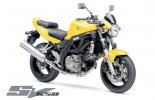Second the advice to take a training course. When I took mine (1992), they told me that taking the course was the "accident reduction equivalent" of 6 months of street experience on a bike. The people teaching my course had "school bikes" that you could ride if you didn't have your own. Were I starting over, I would seriously consider taking the course on one of their bikes
before you choose the bike you're going to buy. If nothing else, it will give you a good feel for riding before you go "trying out" bikes to buy.
Oh, you also save money on insurance if you take the class (with most companies).
When you go to buy, you can ask for a test ride, but don't expect to be allowed. Bikes are easy to mess up with a little spill, and most smart sellers won't want to let you test them out unless you write out a contract that you are buying the bike for the duration of the test ride, full price to be refunded if the bike comes back okay.
For commuting and "around town", a scooter would definitely get you by. If you want to be able to drive for a longer time (say... hour and a half or so), you'll want a larger scooter or a small cycle (250cc or so). For longer trips at interstate speeds, a bigger bike (600cc) will do fine, without getting insanely expensive or using lots of gas. A 600 will also be more comfortable for passengers, if you ever think you'll carry one.
As for storage, the only bikes that come with much at all are the really big touring bikes like Goldwings, and you don't want to start riding with an 800lb bike. Pretty much any storage you have will be aftermarket add-on bags, or backpack/courier bags. I have one of the Aerostich courier bags, and it was great when I was still riding.
I have to differ with jackknife on the expense of motorcycles. I bought a 1992 Yamaha Seca II (600cc economy bike) like this one:
It was $3755 off the lot, brand new. It consistently got 55mpg, could tie a Dodge Viper 0-60 (4.4 seconds), and easily cruised at interstate speeds. Don't think I ever had a problem with the engine, and my only real issues with it were caused by my negligence. I ended up putting about 60,000 miles on it.
In contrast, the bike I purchased after that was an '89 BMW R100GSPD
(This is a picture taken of my old bike by the guy I later sold it to, and posted online. Strange finding it while searching for an image)
While a great deal of fun, this bike only got about 35mpg. (Newer boxers with fuel injection get around 43, IIRC)
So, after that rambling, here's what I suggest if you want to commute on a bike:
Take the training class. After you take it, before you get your bike, start thinking like a biker. Pay more attention to the road than you normally do. When I was riding, I was in Florida and it wasn't uncommon at all to find thin patches of sand here and there on the road. If you get used to looking out for that type of thing before you get on your bike, you'll be less likely to have your tires slip out from under you when you finally get to riding.
Buy a light bike/medium scooter. (Honda Nighthawk 250's are supposed to be nearly bulletproof, get around 70mpg, and have plenty of power to get you in trouble if you want to.) Ride this bike for at least 6 months or so, to make sure you're liking it, then consider if you need a bigger bike, or if the smaller one will suffice.
Buy a good quality rain suit. (I have an Aerostich Darien suit... $800, but kept me warm and dry while I commuted on my bike. You can spend much less to buy a decent suit.. this is high-end)
Buy good quality boots and gloves. Waterproof is good. Glove liners so that you can add insulation are good.
Buy a good full-face helmet. More protection from the road and from the elements than a 3/4 helmet or those stupid little salad bowl things that Harley riders love.
Enjoy riding!
Fox


